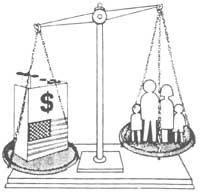World population situation in 1989. Women priority
1989/06/01 Jauregi, Mariaje - Elhuyar Fundazioa Iturria: Elhuyar aldizkaria
Report of the United Nations Population Fund 1989
The 1989 United Nations Population Fund report, after analyzing the relationships between women, population and development, states that investment in women is the key to the future.
“The key to the future may be the degree of women’s freedom to make decisions about their lives. Not only in poor countries, but also in the richest. Women, such as mothers, food producers and suppliers, politicians, etc., play a fundamental role in the process of change.”
Consequently, the goal for the 1990s is to invest in women.
Women priority

Women have a leading place in development. In addition to controlling most of the world's non-monetary economy (subsistence agriculture, parenting and child education, housework, etc. ), plays a very important role within the monetary economy. But the problem is that although women around the world do two types of work, domestic and external, most of that work is not considered work. And not considering it as work means they have no help.
The report refers to the costs resulting from the abandonment of women's needs, such as uncontrolled population growth, high infant and youth mortality rates, the weakening of the economy, the increase in inefficient agriculture, the deterioration of the environment, the widespread fragmentation of society and a lower quality of life for all. In addition, young people and women, inequality of opportunities, the greatest risks and the need to lead a life imposed by others, rather than being in their hands the course of their life.
Many women, especially in developing countries, have no choice but marriage and motherhood. These women, as expected, have large families. If you invest in Emakunde, you would expand the range of strategies you would have at your disposal and cease to be dependent on the social and welfare consideration of the sons and daughters.
The report shows that change at a particular point in women's lives, both for and against, affects everyone. However, introducing changes means recognizing that women are more than their wife and mother, rethinking all development plans. In fact, in principle anyone can admit the implementation of social assistance services for women, but prioritizing investment in women in the development effort requires reflection on the conception of development. Not only for developing countries, but also for financial and credit institutions.
In the last four years, the growing economic pressures of the 37 poorest countries have reduced health care spending by 50% and education spending by 25%. These kinds of measures penalize the poor and women mainly among the poor. (In countries where men are valued more than women, the scarce coins are allocated to the health care and education of children, who are going to get more money in the future, those who are going to have the right to property, etc. ).

Investment in women must be prioritized to bring about changes in development, even in countries with economic difficulties. And changes are necessary. Faced with current conditions such as population growth and overcrowded cities, the growing environmental crisis, rising international debt and increasing poverty in the poorest developing countries, many experts have pointed out that the time has come for an in-depth rethink. The answer lies in the dynamic balance between human and natural resources: more efficient use of limited resources, slower and more balanced growth of the workforce, enhancing health, education, improving food and personal development, etc. And not only for women, but for the whole population.
Investing in women is not panacea. It will not put an end to poverty, it will not eliminate serious inequalities between people and countries, nor will it slow down population growth, nor will it guarantee the salvation and peace of the environment, but it will contribute to achieving all these objectives.
Current world population
The weakest points of the world system are population growth, population location and environmental deterioration. The damage suffered by the Earth is becoming more noticeable. This deterioration is largely due to the excessive use of resources in the richest countries. But there is another reason and it is the combination of poverty and rapid population growth.
The current world population of 5.2 billion will increase every year 90 million until the end of the century. With the exception of six million, the remainder of this annual growth will reside in developing countries. According to United Nations estimates, at the end of the century the world population will amount to 6.250 million. Growth could be disrupted by reaching 10 billion, that is, twice today's figure, perhaps after a century.
But this is a very positive projection. To achieve these figures, users of family planning services should increase considerably (58% by 2000 and 71% by 2025). Otherwise, the population will grow longer and at a faster rate to reach 14 billion people.
These figures and their possible repercussions on the future of the world show that the demographic crisis demands immediate solutions. The problem cannot be left for the next century. Then it will be too late.
Women's status and social and economic self-determination are critical to addressing these kinds of problems.
Woman seeking self-determination

The changes taking place in all developing countries condition (not always for the benefit) the situation of women. Participation in Trade and Agriculture has been very important and is being included in the formal market, but women have less economic security than men. On the one hand, because they have fewer opportunities for access to the labor market and access to productive resources (in some countries, for example, the widow woman may lose the right to cultivate those who had been family lands, and if she wants to continue, she must marry her husband's brother) and, on the other hand, because after she has entered normally, she has to carry this activity along with the mother and the woman.
On the other hand, many young women remain chained in the networks of a lot of traditional values. According to these values, the main function is reproduction, which does not add any importance to other activities. Their status depends almost exclusively on their mother's success. And not only success, but also security, because children (and mainly children) have been the way to ensure their subsequent protection. Many of these practices have had a secular tradition and are fully integrated into the social structure, having been positively valued many of the reasons for women's subordination.
All practices have led to the insecurity of the woman, since other common causes of insecurity have traditionally been the change of residence (when married, the need to go to the home of her husband, depending on him and his family), premature marriages (the generally older husband), sterility, old age, female discrimation (in health, education, etc. ), malnutrition, conformity pregnancies, excessive maternity risks, etc.
To these usual causes we must add more recent ones such as the instability of the environment, the migrations that occur as a result of this and the strengthening of commercial crops (the work that previously carried out women have passed into the hands of men).
Environmental instability
“As a young man, early in the morning we used to go to the forest without eating. There we ate to satiate berries and wild fruits and drank fresh water accumulated in the roots of the banj. We immediately picked up the grass and firewood we needed. Now the trees have disappeared and everything else.” What women say about the Uttarrakhand mountains in India has become a common occurrence. Until recently, what was necessary to meet their needs was found in nearby lands. However, today they have to travel many kilometers to supply the house.
Currently, tropical forests of 11 million hectares are being dismantled; wind and rain erosion is taking 26 billion tons of land, each year a new desert of 6 million hectares is being formed, where the accumulation of salt and stabilized waters endanger half of the irrigated fields of the planet.

The most serious consequences are individual people (mainly the poorest inhabitants and especially women). Women have to travel the longest distances year after year to collect wood in ever smaller forests. They have to walk long hours to find uncontaminated water. They are the ones who, in short, have to face the serious consequences that degradation and environmental pollution produce on the health of their families.
And the worst is that the pressure of the rural population is the cause of this deterioration, but the main culprit is the dumping of a forest that is destined to the reproduction of rotations for logging and commercial crops. In the absence of external interference, conventional communities maintain their balance with the environment, by default relying on it and trying not to consume more resources than they can restore.
The growth of the population and the difficulties posed to them by the ever poorer lands to obtain a good harvest make the inhabitants of the villages turn to the cities to seek work. It seems that escaping the villages should relieve pressure on this fragile environment, but it is not so, since the needs of the cities demand even greater pressure. In Africa, for example, the consumption of wood and coal by the inhabitants of the cities has influenced more the reserves of wood than the whole villages. All the great cities of the Sahel region (Ouagadougou, Dakar, Niamey) are surrounded by a great ring of destruction.
Lack of land, fuel shortages, pollution and migration increase women's insecurity for the future. Many are forced to carry out actions that further aggravate their future security, so in countries with wood shortages they use manure as fuel rather than as manure, although they know that by eating today they are mortgaging tomorrow's food.
Recommendations
In summary, the recommendations of the United Nations Population Fund to Governments are as follows:
- Need to document and disseminate women's contributions to development.
- Improve the productivity of women and streamline the double work in their care.
- Provision of family planning services.
- Provide resources to improve women's health.
- Improve education.
- Equal opportunities.
- Objectives for the year 2000.
To ensure the implementation of these recommendations, the following specific targets are set for 2,000 years.
- International aid for family planning programs, increase annually from 500 to 2.5 billion dollars.
- Consider family planning as an integral priority for development, equating it to large economic investments. At least 1% of countries' GDP should be allocated for this purpose.
- Extend family planning services until its users reach 500 million women.
- Ensure that all people have close basic health care and family planning services.
- Ensure that all women are cared for at least once in each pregnancy in the care center.
- Reduce maternal mortality by at least 50%.
- Reduce the death of children less than a year to 50% of live births.
- Increase enrollment in female primary education to a minimum rate of 75%.
- To ensure that in secondary education, in 2000, girls' enrolment is at least 60%.
- Act against the illiteracy of women to literacy at least 70% of the female population.
In addition to the population scope, these objectives are aimed at entities and organizations with specific development objectives. They consider a coordinated collaboration between all essential for success.

Gai honi buruzko eduki gehiago
Elhuyarrek garatutako teknologia




